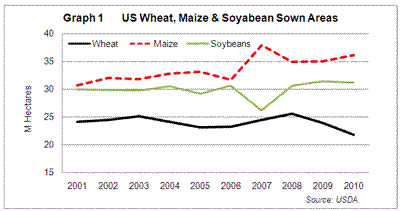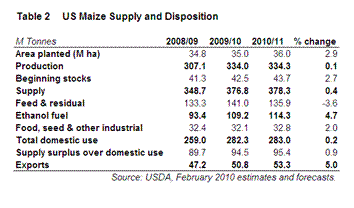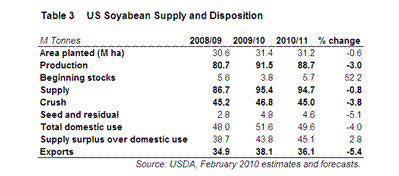
USDA Outlook Forum Supply and Demand Forecast
- Tuesday March 2, 2010
This analysis featured in the March 2, 2010 issue of the HGCA's MI Prospects, Volume 12, Issue 17
Key Points
The USDA supply and demand projections for the 2010/11 US crop year indicate a rise in supply surplus over domestic needs for wheat, maize and soyabeans, despite a small forecast decline in overall planted areas and yields below last year's record levels. Wheat and maize exports are projected slightly higher by 3 and 5%, respectively, based on Western Hemisphere prospects and on a recovery in general economic conditions. Soyabean exports are projected to decline by 5% due to higher South American output.
The USDA traditionally publishes its first supply and demand projections at its Outlook Forum in late February / early March. These are prepared by the same group who subsequently release monthly revision to this data from May onwards. The difference between the two is that the later revisions generally result from survey data, while the Forum information is based on more speculative economic assessment. The Forum data is limited to US wheat, maize, rice and soyabeans. 2010 Planting prospects
In assessing supply prospects, however, the USDA had access to a January's winter wheat area survey results and the impact of very adverse field conditions late in 2009. The winter wheat area is the lowest in 97 years with lower price outlook, late soyabean and maize harvests and wet field conditions being cited as the causes for the decline. Spring sowing of wheat is not expected to materially alter this since in areas which have missed winter sowing opportunity, the option of spring sowing is quite limited. In the Corn Belt other spring crops are likely to be preferred. The combined area of maize and soyabeans is expected to increase for a fourth consecutive year (Graph 1).
continue
Since fertilizer costs have declined significantly since last spring, a swing to maize planting and to a small degree away from soyabeans is anticipated. This will be further accentuated by a decline in double cropping of wheat and soyabeans, which is a result of lower expected returns from these crops. In the south there has been some relative improvement in cotton prospects and some area is expected to return to the production of cotton this year.
The USDA also noted that all land released from the Crop Reserve Programme does not find its way into production immediately. This may have been further delayed by wet conditions last fall. Much of the land released from the programme is in the Great Plains and suited only for wheat production. About 1.0M ha of land left the Conservation Reserve Programme last October. Despite this, the aggregate area sown to wheat, maize and soyabeans is forecast to decrease by 1.5% or 1.3Mha.
Wheat
With a 9% reduction in overall planted US wheat area to 21.8M ha, average abandonments and trend yields, a 2010 crop of 52.9Mt is forecast (Table 1). Wheat yields are projected below the simple trend of national average yields as the area of higher-yielding Soft Red Winter wheat has fallen most. The USDA noted that although wheat conditions have declined since early December in the Hard Red Winter wheat states, more wheat is in good-to-excellent condition than at this time last year. The condition of Soft Red Winter wheat is less favourable. For Hard Red Spring and durum wheat a forecast decline in yield from last year's record to long-term trends will more than offset any increase in spring wheat planting.
continue
Prospective wheat supplies for 2010/11 are seen at 82.6Mt which is about 2% above last year, as the large projected ending stocks of 26.7Mt more than offset reduced production. Domestic milling usage is forecast to increase slightly as a result of a decline in flour yields from this season's very high levels. Also, wheat feeding during the summer quarter is forecast to rise but is likely to be limited by relatively strong prices compared to maize. Feeding wheat in the US is geographically limited and the supposition is that Soft Red Winter wheat is going to be in short supply in those areas. All wheat supply surplus over domestic needs is forecast on par with that of the current crop year.
A 3% recovery from this season's 38-year low in exports to 23.1Mt is expected as a result of improved prospects in the Western Hemisphere. This stems from lower competing supplies from Canada at least until the Argentine harvest that occurs post December 2010. No recovery of traditional market share in the Mediterranean basin is expected.
Maize
The 2010 US maize production is projected at 334.3Mt,
which is based on a 3% area increase, normal forage
maize areas and trend yields. The forecast output would
be very slightly higher than last year's record crop of
334.0Mt (Table 2). Larger beginning stocks will also mean
that total supplies will be slightly above this season at
378.3Mt. A 5% increase in ethanol usage to 114.3Mt,
resulting from a higher mandate, will more than offset an
anticipated decline in feed usage. The ethanol usage
forecast accounts for more than 40% of total domestic
maize consumption in the US. Weakness in consumer
demand for soft drinks is expected to limit growth in
sweetener production. A forecast supply surplus over
domestic needs of 95.4Mt is still slightly above this year.
Maize exports are projected to increase modestly by 5%
to 53.3Mt. This is based on the expectation that world
livestock production will rebound from the global livestock
recession. Abundant supplies of feed quality wheat are
seen as a major competing factor.
continue

Soyabeans
The US 2010 soyabean crop is forecast to decline by 3% to 88.7Mt. The forecast is based on slightly lower soyabean plantings but on a slightly higher harvested area. It also assumes lower but normal abandonment and trend yields (Table 3). But given large beginning stocks, total supplies will only be down 1% on 2009/10. The domestic crush is forecast to decline by 4%. US soyameal export markets are being eroded by increased competition from South America, as well as increased supplies of dried distiller grains, a by- product of ethanol production, and imports of canola meal into domestic markets. The preference for reduced trans-fat-vegetable oils continues to reduce soya oil food markets. A rebound in biodiesel usage is projected to offset this.
continue
Supply surplus over domestic needs will rise by 3% to 45.1Mt. Exports are forecast to fall by more than 5% due to increased competition from South America for Chinese imports which increasingly dominate this market.
Concluding remarks
Although anticipated US adjustments to international market developments are important, and particularly so for wheat, their impact on global prospects are small. The International Grain Council projects a 30Mt rise in wheat supplies over the coming year, whereas it would probably require a 30Mt fall to enhance prospects significantly. The 15Mt (22%) cut in US production over two years does not alter this. Conversely for maize, the adjustments relate to opportunities provided by rising usage. For soyabeans, it will undoubtedly take more than one year to adjust to the impact of last year's South American crop losses.
David Walker (001) 780 434 7615
top of page